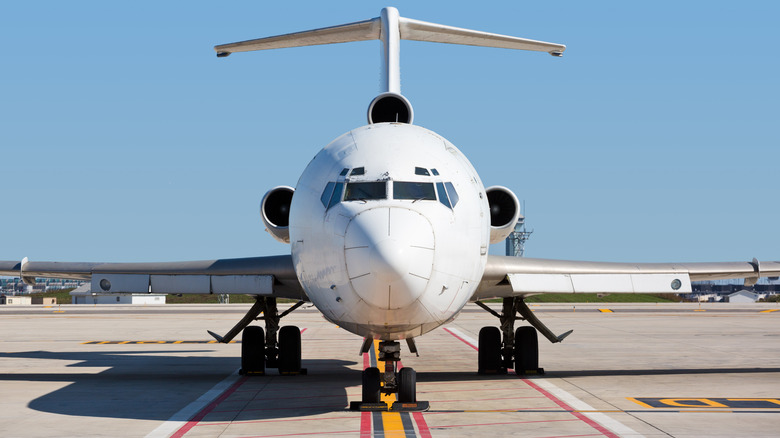The Fascinating Time Scientists In Mexico Purposely Crashed A Boeing 727
Back in 2012, an extravagant aviation experiment took place when a group of researchers crashed a Boeing 727 into a Mexican desert (via USA Today). The scientists had the backing of the Discovery Channel, and the entire thing was filmed for your entertainment for an episode of the show, "Curiosity." The two-hour-long program explores the realities of a terrifying plunge from the air (via IMDb).
According to Aviator Insider, a 727 aircraft costs in the range of $2.9 to $9.5 million — a rather expensive piece of equipment to wantonly destroy. However, it was a small price to pay for valuable data gained from the experiment. Crucial information from crashes is often used to improve plane safety, helping preserve the lives of millions of flyers every year (via PBS). At the time of filming, only one other test crash was ever attempted (via The Daily Mail). The surprising findings from the particular experiment in question proved to be of great interest — and they may just save your life should you ever fall foul of a busted airplane engine.
Planning the Crash
Before they could send the plane careering to the ground, six crew members were needed to get the aircraft into the air and on course. One by one, they parachuted from the plane, with the last two crew members jumping just 8 miles from the intended crash site (via USA Today). From there, a remote control took over, and the plane hit the floor at 140 miles per hour (via Insider).
Although the site chosen for the crash was a dry lake bed in Mexico, the original location the crew wanted to use was China Lake in California. However, the location was moved after the experiment was deemed too insensitive by Federal Aviation Administration (FAA) officials, who were concerned it would evoke painful memories of a 1984 test crash (via NASA).
One goal of the experiment was to test the effects of the impact on the human body. To that end, crash test dummies with actual breakable skeletons were placed in various locations on board the craft (via The Daily Mail). Each dummy was decked out with 32 individual sensors and cameras were placed on board to record the crash. From the ground, the impact was filmed from a variety of different angles.
Brace for impact
The results of the experiment revealed how humans can survive such a perilous drop from the sky (via USA Today). According to the Daily Mail, the safety demonstrations you are given at the beginning of a flight can save your life. Of the three dummies used, the one not wearing its seatbelt and the one not in the brace position both "perished" in the wreckage. The third dummy, arranged according to safety instructions, escaped with its spine intact.
The flight also demonstrated that you are more likely to die in a plane crash if you sit in first class because the front is considered the most dangerous part of the plane in the event of a crash. The nose of the plane used in the experiment broke off from the wreck, although it is possible that the pilots could have survived (via Insider).
On the whole, the test crash showed that most people would probably have survived such a drop. Although we tend to remember terrifying crashes that kill all their passengers — such as the 1977 Tenerife crash that killed 583 people (via PBS) — your chances of surviving a plane crash are surprisingly high. According to BBC News, around 90% of crashes are survivable, and data from the 1980s and 1990s have shown that, on average, 55% of people survive even the very worst airline disasters.


